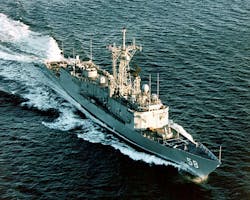A Spell to Reanimate a Frigate's Disabled Communications System
Get the complete compendium of troubleshooting articles. Download Now in PDF Format.
Thirty some years ago I was in the Navy. I was an electronics technician or "ET" on the guided missile frigate Samuel B. Roberts, FFG-58. My specialty was maintaining all the HF, UHF and cryptographic gear associated with the communications gear.
We were on deployment somewhere in the Atlantic. When you're in the Navy, "exercise" has two meanings - one is physical, the other is like practicing for battle. The radiomen were doing an exercise where they had to maintain constant contact with NAVCAMS LANT, or Naval Communications Area Master Station Atlantic (now you understand why we use acronyms) for an extended period of time.
This particular exercise was called "HF Long Hauls. “This was an HF communications channel, somewhere around 2 MHz. It was using FSK, (Frequency Shift Keying) and required a constant carrier. So, the HF transmitter was constantly "keyed down" at about 1KW power.
The transmitters easily tolerated this, so I wasn't too concerned. But after beginning the exercise, it was noticed that all communications from HF to UHF were disabled, including satellite reception. At first, we did not make the connection, so we looked for common threads, namely the rubidium time standard that fed all comm gear. It was fine.
Baffled, we muddled around until the sun went down. As it grew dark, we heard word of a "fire" near one of the three 35-ft HF whip antennas. I ran up and found a shipmate with a CO2 bottle about to douse what appeared to be an electrical fire, although it was hard to tell what was happening in the dark.
I quickly realized what was going on and asked the radiomen to un-key the HF transmitter being used for the long-haul exercise. Immediately, the "fire" went out. Also, all the communications were restored to normal.
In the Navy's never-ending battle with corrosion, they employ many seamen to chip, grind, and paint the ship. In order to do a thorough job, one industrious sailor had disconnected a bonding strap from the base of the antenna. Left hanging about 2 inches from the hull, it made a great spark gap.
As soon as power was applied to the antenna, an arc was struck. The resultant broad band RFI (remember spark gap transmitters?) wiped out reception on all of our communication channels.
A wire brush and a bolt cured the problem. I was the hero for a moment, on a ship that turned out to have many heroes, but that's another story. This event led to a complete bonding and grounding survey (and resultant training for the painters). There are many unintended antennas on the topside of a Navy ship.
It's good to exercise--that problem would have been much more serious had we been in a real situation!
Jim Muehlberg is a retired Navy Chief and Senior Engineer at the National Radio Astronomy Observatory where he currently oversees maintenance and repair local oscillators in the Atacama Large Millimeter Array Radio Telescope.
NOTE: This article is a submission in ED's 2018 Halloween essay contest "Double, Double Toil and Troubleshooting."
About the Author
Jim Muehlberg 1
Electronics Engineer, National Radio Astronomy Observatory
Jim Muehlberg is an Electronics Engineer at the National Radio Astronomy Observatory, Front End Local Oscillator Group.
